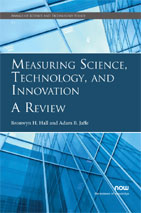Measuring Science, Technology, and Innovation: A Review
By Bronwyn H. Hall, University of California at Berkeley, USA and Max Planck Institute, Munich, Germany, bhhall@econ.berkeley.edu | Adam B. Jaffe, Brandeis University, USA, ajaffe@brandeis.edu
Abstract
The measurement of scientific, technological, and innovative activities (STI) in the economy is an increasing challenge faced by statistical agencies around the world. In this review, we survey the current state of the art.We discuss the concept of indicators, their quality and use, and present a schematic model of the STI system that can help us identify gaps in the set of indicators commonly in use. We then review the developments in STI measurement that have taken place in the rest of the world, particularly the widespread use of innovation surveys. The monograph concludes with a discussion of the measurement gaps and issues in the U.S., which we identify as innovation (especially in the service sector), non-R&D investment related to innovation, data timeliness, data linkages, measurement related to public policy goals, and the sources of capital for innovation.
Measuring Science, Technology, and Innovation: A Review
The measurement of scientific, technological, and innovative activities (STI) in the economy is an increasing challenge faced by statistical agencies around the world. Measuring Science, Technology, and Innovation: A Review surveys the current state of the art including the concept of indicators, their quality and use, and a schematic model of the STI system that can identify gaps in the set of indicators commonly in use. The authors review the developments in STI measurement that have taken place in the rest of the world, particularly the widespread use of innovation surveys. The monograph concludes with a discussion of the measurement gaps and issues in the U.S., which we identify as innovation (especially in the service sector), non-R&D investment related to innovation, data timeliness, data linkages, measurement related to public policy goals, and the sources of capital for innovation.
After an introduction, Section 2 summarizes the framework for analysis of the STI system that is most widely used by economists. Section 3 considers how the specific data currently collected by the U.S. government, and indicators constructed from those data, relate to the important concepts within the framework. Section 4 expands this discussion by reviewing data collected and indicators published by other countries and international organizations. Section 5 then turns to the issues of policy, and draws explicit connections between important policy questions and indicators, using the framework of Section 2. Section 6 builds on these discussions to highlight gaps and issues with the existing indicators, and Section 7 provides concluding comments.
